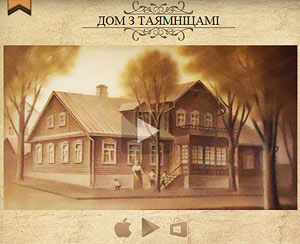Ru
|
Eng
Interactive game to study Maksim Bogdanovich creative works
03.10.2014

School students will be able to study the creative works of Maksim Bogdanovich with the help of a computer game, House of Secrets, created under an international project, The Virtual Past is a Keystone for the Future of Museums, of the cross-border cooperation program Lithuania-Latvia-Belarus 2007-2013, BelTA learnt from coordinator of the project on Belarus’ behalf, worker of the Grodno History and Archeology Museum Svetlana Rapetskaya.
The game is based on the materials of the Maksim Bogdanovich Museum in Grodno, the biographical information and creative work of the poet. While playing the game school students get information on the childhood and Grodno period of life of the poet, his neighborhood and the urban environment of that time. The game consists of several levels and takes the players onto a trip to the memorial rooms of the museum. The game speaks Belarusian and offers a great deal of puzzles. The game is designed to school pupils and students as well as everyone who is interested in history and poetry.
The game has already been tested on Grodno school students, and teachers are eager to use it for the educational purposes, Svetlana Rapetskaya noted.
The project, The Virtual Past is a Keystone for the Future of Museums, is implemented by Rezekne Higher School (beneficiary, Latvia), the Museum of Kedainiai Region (Lithuania), the Grodno History and Archeology Museum (its literature subsidiary) and the Latgale Culture and History Museum (Latvia). Every participant developed a game to familiarize children with the funds of the establishment. The games developed by the abovementioned institutions are Clay Transformations by the Latgale Museum, Recreate the Arnet House by the Museum of Kedainiai Region and a research and historical game Go There, Don’t Know Where, Bring It, Don’t Know What by Rezekne Higher School. All the games are free of charge and available at www.futureofmuseums.eu. The site is a multilingual cross-border virtual museum telling about all four establishments.
According to Latvian curator of the project Ilga Shuplinskaya who spoke at the presentation on 2 October, the major objective of the project is to attract children and the youth with both museum expositions and historical and human values. “We understand that in studying history today’s youth can be lured by a computer game and we have chosen this way. Every partner created a game for a certain age. The Belarusian game is designed for primary-school and preteen students. The Lithuanian game is aimed at seventh to ninth graders. The Latgale game is universal, for creative people of different age, while the game of Rezekne Higher School is for school pupils and students interested in history. Every game has its concept, search elements, riddles, logic chains,” she said.
According to game developers, representatives of Latvia’s MS-IDI Krisjanis Daugulis and Imants Zarembo, the museum games are available for PCs and other mobile devices. The games offer 2D and 3D graphics and hand control. The games have already gained popularity. Rezekne Higher School alone has registered over 20,000 downloads so far.
The game is based on the materials of the Maksim Bogdanovich Museum in Grodno, the biographical information and creative work of the poet. While playing the game school students get information on the childhood and Grodno period of life of the poet, his neighborhood and the urban environment of that time. The game consists of several levels and takes the players onto a trip to the memorial rooms of the museum. The game speaks Belarusian and offers a great deal of puzzles. The game is designed to school pupils and students as well as everyone who is interested in history and poetry.
The game has already been tested on Grodno school students, and teachers are eager to use it for the educational purposes, Svetlana Rapetskaya noted.
The project, The Virtual Past is a Keystone for the Future of Museums, is implemented by Rezekne Higher School (beneficiary, Latvia), the Museum of Kedainiai Region (Lithuania), the Grodno History and Archeology Museum (its literature subsidiary) and the Latgale Culture and History Museum (Latvia). Every participant developed a game to familiarize children with the funds of the establishment. The games developed by the abovementioned institutions are Clay Transformations by the Latgale Museum, Recreate the Arnet House by the Museum of Kedainiai Region and a research and historical game Go There, Don’t Know Where, Bring It, Don’t Know What by Rezekne Higher School. All the games are free of charge and available at www.futureofmuseums.eu. The site is a multilingual cross-border virtual museum telling about all four establishments.
According to Latvian curator of the project Ilga Shuplinskaya who spoke at the presentation on 2 October, the major objective of the project is to attract children and the youth with both museum expositions and historical and human values. “We understand that in studying history today’s youth can be lured by a computer game and we have chosen this way. Every partner created a game for a certain age. The Belarusian game is designed for primary-school and preteen students. The Lithuanian game is aimed at seventh to ninth graders. The Latgale game is universal, for creative people of different age, while the game of Rezekne Higher School is for school pupils and students interested in history. Every game has its concept, search elements, riddles, logic chains,” she said.
According to game developers, representatives of Latvia’s MS-IDI Krisjanis Daugulis and Imants Zarembo, the museum games are available for PCs and other mobile devices. The games offer 2D and 3D graphics and hand control. The games have already gained popularity. Rezekne Higher School alone has registered over 20,000 downloads so far.
SCIENCE. TECHNOLOGY. INNOVATIONS
13.08.2024
28.06.2024
28.06.2024
25.06.2024
05.06.2024
15.05.2024
15.05.2024
26.04.2024
26.04.2024
26.04.2024













